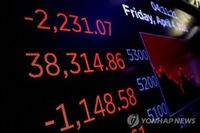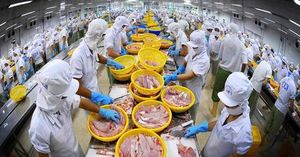On April 6, 2025, the financial landscape took a dramatic turn as U.S. stock futures plummeted, signaling a continuation of the previous week’s panic in the markets. The Dow Jones Industrial Average futures fell by 4%, losing 1,531 points, while the S&P 500 futures dropped by 4.3% and the Nasdaq 100 futures fell by 4.7%. This tumultuous shift in the market suggests that the New York Stock Exchange is unlikely to recover from the turmoil it faced the prior week.
The S&P 500 index experienced a staggering 10% drop over Thursday and Friday, marking a significant decline of 20% from its record high in February 2025. Similarly, the Nasdaq Composite Index fell by 6% on both days, bringing its total decline to 22% from its peak. Investors are increasingly alarmed, with fears mounting that the tariffs imposed by President Donald Trump could trigger a global trade war that would severely impact the U.S. economy.
JP Morgan Chase has projected that Trump's tariffs could impose an annual tax burden of $660 billion on American consumers. The firm has also raised the likelihood of an economic recession in the U.S. to 60%, a stark warning that has left many investors on edge. While Wall Street had hoped for a negotiation to ease the tariffs, no signs of a resolution have emerged, leading to growing disappointment.
In a rather detached response to the market chaos, President Trump spent the weekend golfing, seemingly unconcerned about the financial turmoil. He stated, "Soon the U.S. economy will thrive again, and the stock market will rise," urging investors to "hang in there." This sentiment, however, contrasts sharply with the reality many are facing as their investments take a hit.
Meanwhile, Treasury Secretary Scott Besant noted that over 50 countries have approached the U.S. for trade negotiations, but he cautioned that due to longstanding issues, reaching an agreement could take months. The uncertainty surrounding trade policies has only added to the volatility in the markets.
As the situation unfolded, the repercussions were felt across the globe. On April 7, 2025, the KOSPI index in South Korea fell by 5.6%, dropping below 2,330 points. In Japan, the Nikkei 225 index experienced a decline of over 8%, while Taiwan’s stock market saw a staggering drop of nearly 10%. This marked the largest one-day plunge in Taiwan since 1990, with major stock TSMC plummeting by 9.9%.
Bloomberg News highlighted that the overall decline in major Asian stock markets was the largest since 2008, reflecting widespread investor anxiety. As of 3:40 AM Eastern Time on April 7, the S&P 500 futures index was down 3.6%, Nasdaq futures were down 4.5%, and Dow futures were down nearly 3%. The ongoing trade conflict, particularly the tariffs announced by the Trump administration on April 3, has resulted in a staggering loss of $6.06 trillion in market capitalization from the New York Stock Exchange.
Adding to the tension, the Chinese government has indicated its intention to impose an additional 34% retaliatory tariff on all U.S. products, further escalating the trade war. Analysts predict that the financial market shock caused by this ongoing conflict is likely to continue for the foreseeable future.
In the commodities market, international oil prices also took a hit, falling by more than 3% and breaking the $60 per barrel threshold. According to Investing.com, WTI futures prices fell by 3.6%, settling at $59.81 per barrel, while Brent crude futures dipped by 3.5%, reaching $63.24.
As the economic landscape remains uncertain, many investors are left wondering how long this volatility will last and what measures, if any, will be taken to stabilize the markets. With fears of a looming recession and escalating trade tensions, the outlook for the U.S. economy appears increasingly precarious.
In summary, the combination of Trump’s tariffs, investor panic, and international responses has created a perfect storm in the financial markets. As the situation develops, all eyes will be on how policymakers respond to these challenges and whether they can restore confidence in the markets before it’s too late.






